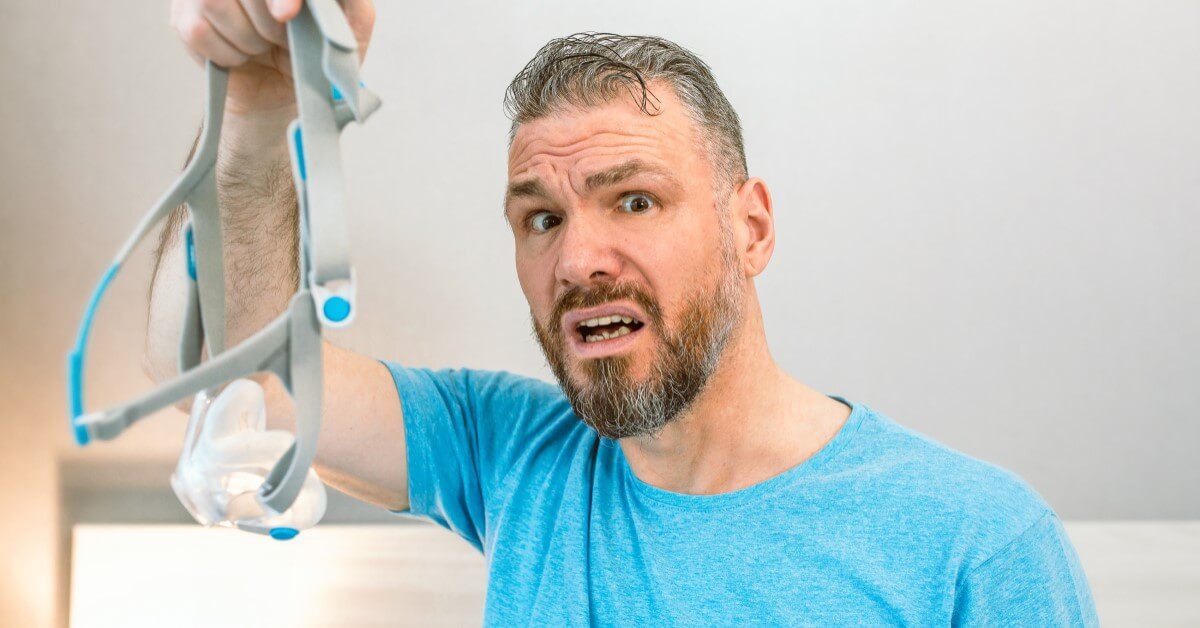The Problem with CPAP | Chronotype Targeting for CPAP Success | The Takeaway
Overview
Untreated sleep apnea is linked to many adverse health outcomes, including heart attacks, hypertension, and depression. Continuous positive airway pressure therapy (CPAP) is a highly effective, non-invasive tool to manage the disorder and is considered the gold standard for treatment.
Are you one of the many people with sleep apnea who must wear a CPAP mask at night but find it uncomfortable? If so, you are part of a reasonably large group.
Statistically, up to 40 percent of CPAP users cite discomfort as a driving factor behind irregular use or complete abandonment of this potentially life-saving treatment[1] – and that’s pretty serious.
But science is getting closer to finding another potential solution to this dilemma, and a new study is pointing towards an individualized treatment approach based on our biological clocks.
The Problem with CPAP
CPAP machines improve the wearer’s sleep quality by keeping the airways open as they sleep. Airways get blocked by collapsing tissue around them, which induces choking or gasping, hallmarks of sleep apnea. The brain triggers the gasping of air to rouse you from sleep to ensure you get sufficient oxygen.
So far, attempts at making CPAP therapy more comfortable for users have been mainly from a mechanical angle, such as air pressure adjustment and quieter pumps. Often, finding the right type of mask can do the trick too, but according to new research, comfortability with CPAP usage may come down to your sleep chronotype.[2]
Chronotype Targeting for CPAP Success
Sleep apnea and a person’s circadian rhythms (the body’s 24-hour biological clock) are linked in a bidirectional relationship. For example, sleep apnea can cause circadian rhythm dysfunction, while the body’s internal clock can prolong nightly apnea events.[2]
Considering this bidirectional relationship, a study was conducted on the different chronotypes as defined by animals and their sleep habits: bears, people who are more energetic and wakeful during the day and get sleepy as the sun sets, lions, also known as early birds, and wolves, also known as night owls. These chronotypes were studied to see which one has better adherence to wearing their CPAP.
And the winner? Well, the lion is king in this contest. This early bird chronotype was found to use their CPAP for an average of 40 minutes longer than the other two chronotypes.[3] And that is not an insignificant number. Sleep experts agree that the longer the CPAP masks stay on, the better the sleep quality and health outlook for a person with sleep apnea.
Although it is still unclear what specific mechanisms make naturally early risers more likely to adhere to their sleep apnea regimen, it shows that a person’s sleep chronotype should be considered when prescribing treatment.
The Takeaway
The longer someone uses their prescribed CPAP therapy, the more health benefits they gain over time.[4] This factor makes continuous adherence vital to long-term health.
However, uncomfortable masks, nasal dryness, straps that may be too tight, and air leaks can cause the experience to be challenging to stick to night after night.
A promising new avenue has been opened for more individualized, targeted sleep apnea treatment by looking at individual sleep chronotypes as possible predictors for CPAP adherence.
With this foundation, future studies may shed more light on sleep medicine’s ability to determine the best possible therapy and who may need additional support to ensure that all-important oxygen keeps going to the brain night after night.
References:
- Rotenberg, B. W., Murariu, D., & Pang, K. P. (2016). Trends in CPAP adherence over twenty years of data collection: a flattened curve. Journal of otolaryngology – head & neck surgery = Le Journal d’oto-rhino-laryngologie et de chirurgie cervico-faciale, 45(1), 43. https://doi.org/10.1186/s40463-016-0156-0
- Butler, M. P., Smales, C., Wu, H., Hussain, M. V., Mohamed, Y. A., Morimoto, M., & Shea, S. A. (2015). The Circadian System Contributes to Apnea Lengthening across the Night in Obstructive Sleep Apnea. Sleep, 38(11), 1793–1801. https://doi.org/10.5665/sleep.5166
- Knauert, M. P., Adekolu, O., Xu, Z., Deng, A., Chu, J. H., Baldassarri, S., Kushida, C., Yaggi, H. K., & Zinchuk, A. (2023). Morning Chronotype Is Associated with Improved Adherence to Continuous Positive Airway Pressure among Individuals with Obstructive Sleep Apnea. Annals of the American Thoracic Society, 10.1513/AnnalsATS.202210-885OC. Advance online publication. https://doi.org/10.1513/AnnalsATS.202210-885OC
- McArdle, N., Devereux, G., Heidarnejad, H., Engleman, H. M., Mackay, T. W., & Douglas, N. J. (1999). Long-term use of CPAP therapy for sleep apnea/hypopnea syndrome. American journal of respiratory and critical care medicine, 159(4 Pt 1), 1108–1114. https://doi.org/10.1164/ajrccm.159.4.9807111






